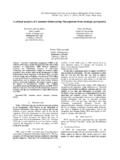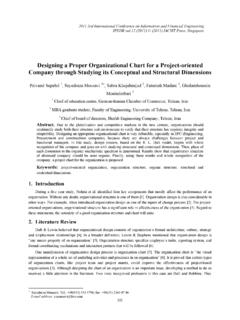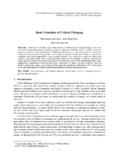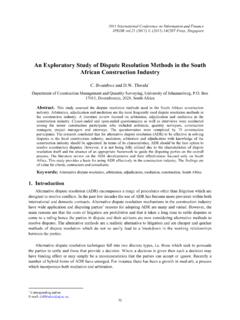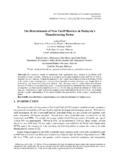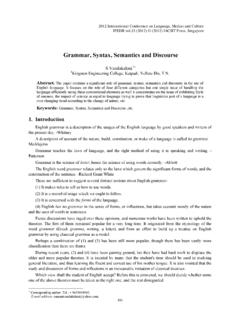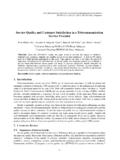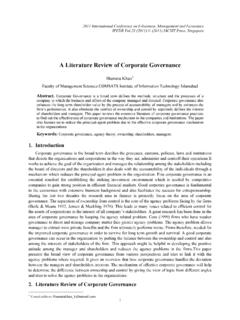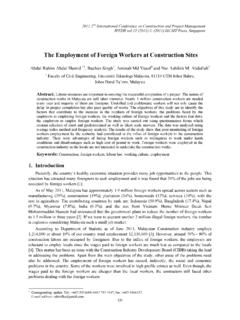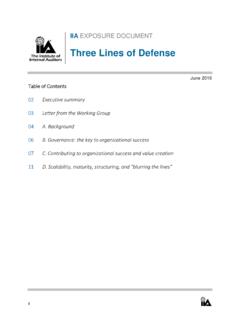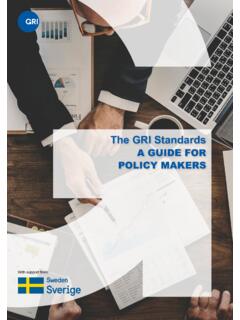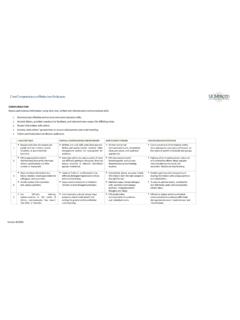Transcription of The Stakeholder Map in Higher Education
1 DOI: 2014. V 78. 7 The Stakeholder Map in Higher Education Juha Kettunen 1 1 Turku University of Applied Sciences Abstract. Although Higher Education institutions and their units have acknowledged some of their important stakeholders, it is important for them to identify and classify the stakeholders in a more explicit way. The purpose of this study is to develop and describe a Stakeholder map for use in Higher Education . The Stakeholder map includes various partners and customers using the perspectives of the Balanced Scorecard approach. The Stakeholder map describes the Stakeholder collaboration and represents a remarkable improvement for a quality assurance system. The Stakeholder map can be used in social responsibility reviews and other reports that describe the quality assurance system of the Higher Education institution.
2 Keywords: Stakeholders, Customers, Partners, Strategy, Balanced Scorecard, Quality Assurance, Higher Education 1. Introduction To significant extent, the success of a Higher Education institution (HEI) depends on its ability to take care of its Stakeholder relationships. Stakeholders include all those organisations, networks and private people that are able to influence the objectives of a given organisation [1], [2], [3], [4]. The internal stakeholders of Higher Education institutions include personnel and students, while the external stakeholders include partners and customers. Higher Education institutions have to respond to the needs of their various stakeholders. The importance of external stakeholders increases when the public funding of Higher Education institutions decreases.
3 The institutions must then look for external funding from various domestic and international funding sources and thus collaborate more with external stakeholders. In such cases, they become responsible to a larger number of stakeholders [5], [6]. Quality assurance is a challenge because the groups of quality assurance audits and institutional accreditations evaluate the Stakeholder relations and the service to society. Therefore, the quality assurance system should include description of Stakeholder relationships. In many cases, the role of stakeholders is described in process descriptions and corporate responsibility reviews and is measured by indicators [7]. The purpose of this study is to develop a Stakeholder map for Higher Education institutions.
4 The Stakeholder map describes the internal stakeholders, strategic and other partnerships and customerships. The Stakeholder map should be part of the quality assurance system, which ensures that the strategic objectives of an institution can be achieved. Therefore the Stakeholder map should follow the same framework used in strategy and quality maps [8]. The remainder of this paper is organized as follows. Section 2 describes the main characteristics of strategic management and quality assurance that should be taken into account when developing the Stakeholder map. Next, Section 3 presents the Stakeholder map using the case of the Turku University of Applied Sciences. Finally, Section 4 describes the main applications of the Stakeholder map and concludes the study.
5 2. Strategic Management and Quality Assurance in the Stakeholder Map Balanced Scorecard For Higher Education institutions, it is necessary not only to identify their stakeholders [9] but also to classify them in order to connect the stakeholders with the strategic management. It is necessary to Corresponding author. E-mail address: 34collaborate with partners and customers who are important for the mission and future success of the institution. Therefore, the stakeholders should be described using the framework used in the institution s strategic planning. The Balanced Scorecard approach developed by Kaplan and Norton [10] is used to translate the vision into tangible objectives and measures that can be communicated to the stakeholders.
6 A good Stakeholder map should have a balanced mix of stakeholders who will help the university to implement its strategic plan. The Balanced Scorecard approach can be classified in four perspectives: 1. External impact. This perspective describes regional development and customer satisfaction created in the processes and collaboration with various stakeholders. 2. Finance. The financial perspective describes the public and external funding from numerous funding bodies for the activities of the institution. 3. Processes and collaboration. The internal and collaborative processes describe how value is created for customers in research and development, support services and Education . 4. Organisational learning. This perspective describes how the personnel and students of the university learn with the help of their stakeholders.
7 These perspectives may take slightly different forms in other universities and organisations with differing missions and strategies. In general, these perspectives have been found to be necessary and sufficient across a wide variety of organisations [10]. Quality Assurance Stakeholders are important from the viewpoint of quality assurance. Because Higher Education institutions stakeholders have some interest or input in institutions, their views of stakeholders have to be taken into account in the quality assurance system of the institution [11], [12], [13]. On the other hand, each Stakeholder may have its own quality assurance system. These two systems should work as reciprocal interaction with each other to enable fruitful collaboration between stakeholders.
8 The Finnish Higher Education Evaluation Council [14] is a quality assurance agency that acknowledges the importance of stakeholders in its quality audits. The purpose of the quality assurance system is to ensure that the strategic objectives and other objectives of the institution can be achieved. The audit groups interview representatives of management, teaching and other personnel, students and external stakeholders during the audit visits. Therefore, the quality assurance system should describe the Stakeholder relationships in the processes of research and development, support services and Education . Higher Education institutions typically have an obligation to set up a quality assurance system reviewed by external stakeholders or quality audits that reflect the responsiveness of the institution on the society.
9 De Wit and Verhoeven [15] found evidence that Dutch colleges are legally obligated to take external viewpoints into account and have more formal contacts with external stakeholders than universities. Universities have remained more autonomous organisations that typically make their own decisions based on informal contacts, but even they have developed into a more market-driven and Stakeholder -oriented structure [16]. On the other hand, there is also evidence from other countries that Stakeholder relationships can be developed to increase the influence of business on Higher Education institutions [17]. The Finnish Higher Education has a dual system, with both traditional research universities and universities of applied sciences.
10 The mission of the universities of applied sciences is to support regional development while taking into account the economic structure of the region. The quality assurance agency evaluates the coverage and effectiveness of the quality assurance system. In Finland, that the external stakeholders have a more significant role in the universities of applied sciences than in the research universities [18]. This is due to the fact that these institutions have applied research and development and professional Higher Education , which are closely linked with the business and public sector. 3. Stakeholder Map The existence and justification of a Higher Education institution can be described and analysed in terms of its Stakeholder relations.

